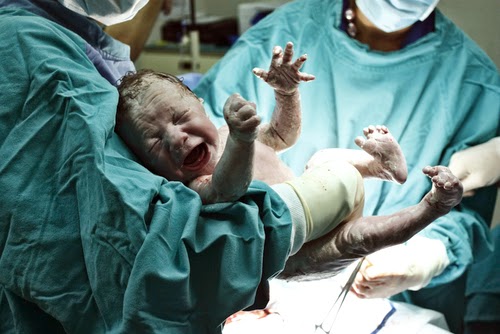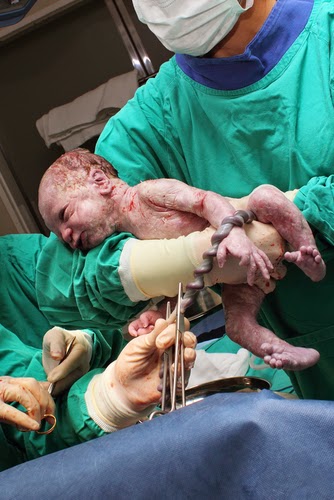
The obstetrics nurses rushed the stretcher through the triage station as the resident tore out of her chair and followed them. I jumped up and ran with her. It was the second night of my obstetrics rotation and there was no time for triaging this patient, who was on the verge of giving birth. And because she spoke almost no English we could not get a history from her. If we had been able to, we would ask all about her gynecologic and obstetric history. Most importantly, we would ask if she had been screened for sexually transmitted diseases (STDs) which can be spread to the baby leading to horrific consequences including severe developmental disorders and death. The baby, though, came too fast for any kind of serious conversation, even with a translator. In women who have given birth before, like this particular mother, the birthing process goes much faster. Therefore, when a multigravid woman comes in and claims that the baby is about to come out, obstetricians immediately rush her into the delivery room.
 |
| Image via Shutterstock |
We transferred the patient onto a bed, pulled out stirrups for her patient’s legs and detached the bottom part of the bed such that half of the patient’s derriere hung off its edge. As she opened her legs I saw the tip of the emerging child’s head, mostly covered in dried amniotic fluid, blood, and other bodily secretions. The resident, attending, and I quickly put on sterile gowns, gloves, and masks and, encroaching on the woman’s privacy (though she didn’t mind just then as she began to howl in pain with each uterine contraction), stood in between her open legs at the entrance to the vagina, our hands ready to catch the baby.
With each muscular contraction of the uterus, the baby inched further and further out into the world. The resident coached the mother, imploring her to push as she continued to scream. In a not-so-surreptitious manner, the father pulled out his iPhone as he stood by his wife’s head and hit “record” to document the birth of the couple’s third child. He wore an enormous childlike grin as he did so, aware both of his slight irreverence and of the imminent addition to his family.
After a few contractions, the baby’s full head emerged and the resident and attending supervised as I delivered the baby. My heart rate skyrocketed; I sweated, trembled, and attempted desperately to remember the childbirth simulation I had been through one week earlier.
The delivery of a baby is not all that complicated when it’s first explained (here’s a proper YouTube video of it — ignore the very corny soundtrack and beware the graphic nature of the video) but try doing it when the time comes and you freeze up very fast. In an ideal world, as the baby’s head appears, one puts pressure on it so that it does not pop out and tear vaginal tissue. Make sure the head rotates so that the baby faces the inner thigh of the mother (also known as external rotation). This rotation also allows one of the baby’s shoulders to emerge. Once that shoulder is out, tip the baby towards the exited shoulder to allow the other emergent shoulder to exit as well. If you try to get both shoulders out at once there is a danger of shoulder dystocia in the newborn — the shoulder of the infant sticks behind the maternal pubic bones leading to anything from transient nerve paralysis in the baby’s arm to compression of the umbilical cord cutting off oxygen supply to the child.
With the resident’s and attending’s hands near mine, I performed the delivery. As I angled the baby’s shoulders and allowed its body to exit the vagina, a huge amount of fluid gushed out — a combination of amniotic fluid, some blood, liquid mucus, and vaginal discharge — and soaked my shoes and gown. Ignoring this, I clutched the child to my stomach to prevent her from slipping out of my arms (not very smooth). You’re supposed to hold the baby in the left arm with the head in the palm and the body resting on your forearm, not clutch the baby to your chest. When babies are born they are frighteningly slippery though. And, fearful of dropping the baby, I used both arms and my abdomen to cradle the child, praying I would not drop her.
I held the neonate below the level of the vagina to allow the umbilical cord, which has vessels that carry oxygenated blood to the baby in utero, to drain all the rest of the blood into the child before cutting it. The resident clamped the umbilical cord on two ends, waited a bit, and then cut it. This prevents the two ends of the cord from bleeding. Simultaneously, the attending suctioned out the baby’s nose and dried off the baby with a towel. Newborns are prone to temperature changes so we dry them off and then wrap them in a blanket to keep them warm. The resident took the child from me and handed her over to her mother while the father continued to use his iPhone to record this remarkable moment. The mother bawled and even the father cried as his smile enlarged to one of complete and unreserved joy. Their perfectly healthy, new daughter held their rapt attention and despite the commotion around them, nothing distracted the parents from this life.
 |
| Image via Shutterstock |
The pediatricians arrived in the room, examined the baby for any malformations (none were found, thankfully) and placed her in a hospital crib. We continued to deliver the placenta, tissue which attaches to the uterus and allows for the umbilical vessels to exchange deoxygenated blood from the baby for oxygenated blood from the mother. It is semi-flat and looks very much like an alien organism — nonetheless it is crucial to the survival of the fetus. After the baby is born, if the placenta remains inside the uterus, there is a greater risk of infection in the mother. I gently tugged on the umbilical cord while I massaged the lower abdomen with my other hand. This helps coax the placenta out of the uterus and also helps to stem the bleeding from the uterus (uterine contraction is integral to cessation of bleeding postpartum). The placenta slowly plopped into my hands; warm, squishy, and bloody. I placed it in a plastic tub and began to clean up all the tools, gowns, and gloves when the resident got a call on her phone: another woman about to give birth two doors down. We rushed out.

